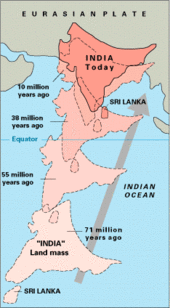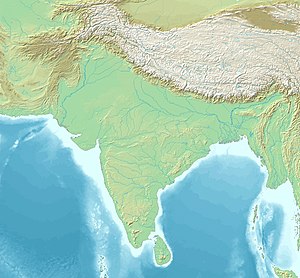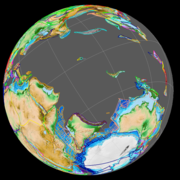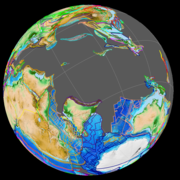Indian subcontinent
Physiographical region in South Asia From Wikipedia, the free encyclopedia
The Indian subcontinent is a geological term describing the landmass known as the Indian Plate, which drifted northeastward from the ancient supercontinent Gondwana and collided with the Eurasian Plate around 55 million years ago.[1][2] The boundary of the continental collision between these plates, called the Chaman Fault, traverses modern-day Pakistan and Afghanistan. The Indian subcontinent is typically defined to include the countries of Bangladesh, Bhutan, India,[note 1] Maldives,[note 2] Nepal,[note 3] Pakistan,[note 4] and Sri Lanka.[note 2][3][4][5][6] It is not known exactly where the Indian plate may end and where the Eurasian Plate may start; it may also include parts of west and northwest Pakistan. Home to nearly 2 billion people, the Indian subcontinent accounts for 25% or ¼ of the world's population.
 Geopolitical coverage of the subcontinent | |
| Area | 4,440,000 km2 (1,710,000 sq mi) |
|---|---|
| Population | c. 1.9 billion |
| Countries | |
| Dependencies | External (1)
|
| Languages | |
| Time zones | List:
|
| Largest cities | |
Although the terms "Indian subcontinent" and "South Asia" are often used interchangeably to denote the region,[7] the geopolitical term of South Asia frequently includes Afghanistan, which is typically not considered a part of the Indian subcontinent.[8]
The Indian subcontinent is one of the most populated regions in the world, holding roughly 20–25 percent of the global population. Geographically, the peninsular region in Southern Asia is located below the Third Pole, delineated by the Himalayas in the north, the Hindu Kush in the west, and the Indo-Burman Ranges in the east.[9] The neighboring geographical regions around the subcontinent include the Tibetan Plateau to the north, the Indochinese Peninsula to the east, the Iranian Plateau to the west, and the Indian Ocean to the south.
Apart from Maritime Southeast Asia (the Malay Archipelago), the maritime region of the subcontinent (Littoral South Asia) is the only subregion of Asia that lies partly within the Southern Hemisphere: the British Indian Ocean Territory[citation needed] two of the 26 atolls of the Maldives lie entirely within the Southern Hemisphere.
Name
Summarize
Perspective
Historically, the region surrounding and southeast of the Indus River was often simply referred to as "India" in many historical sources. Even today, historians use this term to denote the entire Indian subcontinent when discussing history up until the era of the British Raj. Over time, however, "India" evolved to refer to a distinct political entity that eventually became a nation-state (today the Republic of India).[10]
According to the Oxford English Dictionary, the term subcontinent signifies a "subdivision of a continent which has a distinct geographical, political, or cultural identity" and also a "large land mass somewhat smaller than a continent".[11][12] Its use to signify the Indian subcontinent is evidenced from the early twentieth century when most of the territory was either part of the British Empire or allied with them.[13][14] It was a convenient term to refer to the region comprising both British India and the princely states.[15][16]
The term has been particularly common in the British Empire and its successors,[17] while the term South Asia is the more common usage in Europe, North America as well as in most country's in South Asia it self some times.[18][19] According to historians Sugata Bose and Ayesha Jalal, the Indian subcontinent has come to be known as South Asia "in more recent and neutral parlance".[20] Indologist Ronald B. Inden argues that the usage of the term South Asia is becoming more widespread since it clearly distinguishes the region from East Asia.[21] While South Asia, a more accurate term that reflects the region's contemporary political demarcations, is replacing the Indian subcontinent, a term closely linked to the region's colonial heritage, as a cover term, the latter is still widely used in typological studies.[22][23]
Since the Partition of India, citizens of Pakistan (which became independent of British India in 1947) and Bangladesh (which became independent of Pakistan in 1971) often perceive the use of the Indian subcontinent as offensive and suspicious because of the dominant placement of India in the term.[24] As such it is being increasingly less used in those countries.[note 7] Meanwhile, many Indian analysts prefer to use the term because of the socio-cultural commonalities of the region.[24] The region has also been called the "Asian subcontinent",[26][27] the "South Asian subcontinent",[28][29][30][31] as well as "India" or "Greater India" in the classical and pre-modern sense.[7][8][32][33]
The sport of cricket, introduced to the region by British colonialism, is notably popular in India, Pakistan, Sri Lanka, Nepal and Bangladesh. Within a cricket context, these countries are sometimes referred to simply as the subcontinent e.g. "Australia's tour of the subcontinent".[34] The term is also sometimes used adjectivally in cricket e.g. "subcontinental conditions".[35][36]
Geology
Summarize
Perspective
From left to right, rifting of the Indian subcontinent away from Gondwana at 150 million years ago (Ma), 120 Ma, 80 Ma and during the Paleocene

The Indian subcontinent was formerly part of Gondwana, a supercontinent formed during the late Neoproterozoic and early Paleozoic.[2] Gondwana began to break up during the Mesozoic, with Insular India separating from Antarctica 130–120 million years ago[37] and Madagascar around 90 million years ago,[38] during the Cretaceous. Insular India subsequently drifted northeastwards, colliding with the Eurasian Plate nearly 55 million years ago, during the Eocene, forming the Indian subcontinent.[2] The zone where the Eurasian and Indian subcontinent plates meet remains geologically active, prone to major earthquakes.[39][40]
Physiographically, it is a peninsular region in South Asia delineated by the Himalayas in the north, the Hindu Kush in the west, and the Arakanese in the east.[9][41] It extends southward into the Indian Ocean with the Arabian Sea to the southwest and the Bay of Bengal to the southeast.[3][42] Most of this region rests on the Indian Plate and is isolated from the rest of Asia by large mountain barriers.[43] Laccadive Islands, Maldives and the Chagos Archipelago are three series of coral atolls, cays and Faroes on the Indian Plate along with the Chagos–Laccadive Ridge, a submarine ridge that was generated by the northern drift of the Indian Plate over the Réunion hotspot during the Cretaceous and early Cenozoic times.[44][45][46] The Maldives archipelago rises from a basement of volcanic basalt outpourings from a depth of about 2000 m forming the central part of the ridge between Laccadives and the Great Chagos Bank.[46]
Geography
Summarize
Perspective

According to anthropologist Patrap C. Dutta, "the Indian subcontinent occupies the major landmass of South Asia."[47] According to historian B. N. Mukherjee, "The subcontinent is an indivisible geographical entity."[48] According to geographer Dudley Stamp, "There is perhaps no mainland part of the world better marked off by nature as a region or a 'realm' by itself than the Indian subcontinent."[49]
This natural physical landmass in South Asia is the dry-land portion of the Indian Plate, which has been relatively isolated from the rest of Eurasia.[50] The Himalayas (from Brahmaputra River in the east to Indus River in the west), Karakoram (from Indus River in the east to Yarkand River in the west) and the Hindu Kush mountains (from Yarkand River westwards) form its northern boundary.[48][51] In the west it is bounded by parts of the mountain ranges of Hindu Kush, Spīn Ghar (Safed Koh), Sulaiman Mountains, Kirthar Mountains, Brahui range, and Pab range among others,[48] with the Western Fold Belt along the border (between the Sulaiman Range and the Chaman Fault) is the western boundary of the Indian Plate,[52] where, along the Eastern Hindu Kush, lies the Afghanistan–Pakistan border.[53] In the east, it is bounded by Patkai, Naga, Lushai and Chin hills.[48] The Indian Ocean, Bay of Bengal and the Arabian Sea form the boundary of the Indian subcontinent in the south, south-east and south-west.[48]

Given the difficulty of passage through the Himalayas, the sociocultural, religious and political interaction of the Indian subcontinent has largely been through the valleys of Afghanistan in its northwest,[citation needed] the valleys of Manipur in its east, and by maritime routes.[50] More difficult but historically important interaction has also occurred through passages pioneered by the Tibetans. These routes and interactions have led to the spread of Buddhism out of the subcontinent into other parts of Asia. The Islamic expansion arrived into the subcontinent in two ways: through Afghanistan on land, and to the Indian coast through the maritime routes on the Arabian Sea.[50]
Geopolitics
Summarize
Perspective
In terms of modern geopolitical boundaries, the subcontinent constitutes Bangladesh, Bhutan, India, Nepal, and Pakistan, besides, by convention, the island country of Sri Lanka and other nearby island nations of the Indian Ocean, such as Maldives and the British Indian Ocean Territory.[citation needed][original research?][4][5][54][55][56] Unlike "South Asia", sometimes the expression "Indian subcontinent" may exclude the islands of Maldives and Sri Lanka.[7] According to Pawan Budhwar, Arup Varma, and Manjusha Hirekhan, India, Pakistan, Bangladesh, Sri Lanka, Nepal and Bhutan constitute the Indian subcontinent. Budhwar, Varma, and Hirekhan also maintain that with Afghanistan and Maldives included the region is referred to as South Asia.[57] The periphery of the subcontinent, including Bangladesh, Pakistan, and the island chains of Maldives, features large Muslim populations, while the heartland, including most of India, Nepal, and Sri Lanka, are overwhelmingly Hindu or Buddhist.[58] Since most of these countries are located on the Indian Plate, a continuous landmass, the borders between countries are often either a river or a no man's land.[59]
The precise definition of an "Indian subcontinent" in a geopolitical context is somewhat contested as there is no globally accepted definition on which countries are a part of South Asia or the Indian subcontinent.[60][61][62][6] Whether called the Indian subcontinent or South Asia, the definition of the geographical extent of this region varies.[32][33] Afghanistan, despite often considered as a part of South Asia, is usually not included in the Indian subcontinent.[60][63][64][65][66] Maldives, an island country consisting of a small archipelago southwest of the peninsula, while largely considered a part of the Indian subcontinent,[5] sometimes is mentioned by sources, including the International Monetary Fund, as a group of islands away from the Indian subcontinent in a south-western direction.[67][68]
Society
Population
The population of Indian subcontinent is about 1.912 billion which makes it the most populated region in the world.[69] It is socially very mixed, consisting of many language groups and religions, and social practices in one region that are vastly different from those in another.[70]
| Country | Population(2023)[71][72] | % of world[73] | Density (per km2) | Population growth rate[74] | ||
|---|---|---|---|---|---|---|
| 2005–10 | 2010–15 | 2015–20 | ||||
| 171,466,990 | 2.15% | 1301 | 1.18 | 1.16 | 1.04 | |
| 786,385 | 0.00978% | 20.3 | 2.05 | 1.58 | 1.18 | |
| 1,438,069,596 | 17.5% | 473.4 | 1.46 | 1.23 | 1.10 | |
| 525,994 | 0.00647% | 1738.2 | 2.68 | 2.76 | 1.85 | |
| 29,964,614 | 0.384% | 204.1 | 1.05 | 1.17 | 1.09 | |
| 247,504,495 | 2.98% | 300.2 | 2.05 | 2.09 | 1.91 | |
| 22,971,617 | 0.272% | 347.2 | 0.68 | 0.50 | 0.35 | |
| Indian Subcontinent | 1,912,753,691 | 23.322% | - | - | - | - |
See also
Notes
- Excluding:
- Andaman and Nicobar Islands, close to the Malay Archipelago.
- Ladakh, Spiti, and other areas which lie to the north of the Greater Himalayan Mountain Range.
- Significant portions of northeast India which lie on the Indo-Burman Ranges (spanning Manipur, Nagaland and Mizoram) as well as the Tibetan Plateau (northern Arunachal Pradesh and Sikkim)
- As island countries, Maldives and Sri Lanka are sometimes not considered parts of the subcontinent, as they lack geographic contiguity with the mainland. They are considered parts of the region in cultural geography or geology instead.
- Excluding Upper Mustang and other areas which lie to the north of the Greater Himalayan Mountain Range.
- Excluding:
- Significant landmasses from East Balochistan and Khyber Pakhtunkhwa (like Federally Administered Tribal Areas) which are situated on the Iranian Plateau.
- Parts of Northern Areas (like Baltistan) which lie to the north of the Greater Himalayan Mountain Range (completely crammed towards the Pamir and minuscule fragments of the Hindu Kush northwards from the extreme border end near the Wakhan Corridor of Afghanistan).
- Administered by the United Kingdom, claimed by Mauritius as the Chagos Archipelago.
- Disputed territory with undetermined political status. Administration is split between China (Aksai Chin and the Trans-Karakoram Tract), India (Jammu and Kashmir, and Ladakh), and Pakistan (Azad Kashmir and Gilgit-Baltistan). China claims a small portion of the territory, Pakistan claims the majority of the territory, and India claims the entire territory (see: UN mediation of the Kashmir dispute).
References
External links
Wikiwand - on
Seamless Wikipedia browsing. On steroids.





